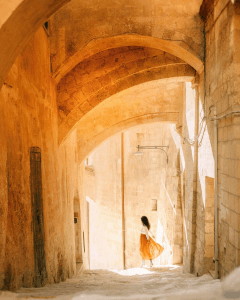To be honest, I had to go out and find this photographer. As you know, I barely use my Instagram, so I had to ask Google for lists of ’15 inspiring photographers to follow on Instagram’.
I stopped at the first photographer on the list. When the article noted that ‘he describes himself as a storyteller first and a photographer second’ I was intrigued.
The photo I have chosen to analyse is this:
Simone Bramante has so many stunning photos I had trouble deciding but I eventually settled on this for its warm simple colours and the way the girl’s skirt flows out behind her.
Who is the practitioner (what is their name?) and when were they practising?
The photographer I have chosen is Simone Bramante, an Italian Instagram photographer with the username @brahmino. He has been a photographer for over 15 years and is currently practising on Instagram.
This photo itself has no title but it is a part of a collection or ‘story’ of photos titled White Labyrinth.
With the photo or video you are examining, when was it produced (date)?
The photo was uploaded to Instagram on the 27th of March 2017. It can be found at the link above.
How was the photo or video authored?
With the iPhone’s increasingly improving cameras and the virality of Instagram, the entry barriers of authoring, publishing and distributing photos are much lower than they were than in the legacy photography age.
Simone Bramante was invited by Carpisa, a bag company, to travel to Matera, Italy for 48 hours.
The photo was presumably taken with an iPhone, maybe with the additional of clamps and a tripod. The girl posing in the photo is a local photographer named Enza.
Unlike film photography, where the amount of photos you could take was limited by the film, digital photography allows you to take as many photos as your phone and cloud storage allows. This photo may have been just one of dozens, perhaps even a burst, from which he selected this one photo, where her skirt fluttered at just the right height.
One interesting element afforded by Instagram and the ease of photo-sharing is the commercial aspect. ‘Photographs attract eyeballs and, where there are eyeballs there lies the possibility to make money’ (Palmer 2014, p.249). Bramante, a photographer, an artist, was hired by Carpisa, a company, to promote their name. Yet, there are no bags in this photo. This isn’t like the product placement in films. The decision behind this promotion is not as straightforward. Bramante was hired to advertise the location of Matera, Italy and by extension, advertise the idea of travelling, and by linking Carpisa in his caption, hopefully infect his 900k+ followers with the travel bug, influence them to travel to exotic places like Matera, and buy some Carpisa bags to help them out.
What a strange world we live in.
How was the photo or video published?
This photo was published to Instagram on the 27th of March 2017. The photo is also geotagged at Matera, Italy. As Palmer (2014) writes, ‘geo-location metadata is commercially valuable’. People searching for Matera, Italy, maybe as a potential holiday destination, might have seen this photo and tagged potential holiday buddies.
In his caption, he added the name of the photo collection, White Labyrinth, as well as a simple, very human musing, the kind that could be found on anyone’s daily Instagram. This is advertising even more ingrained than sponsored posts that work their way seamlessly into feeds. This is advertising within a regular Instagram account, one that earned your follows and likes honestly, through their content.
Perhaps this is why people tend to react negatively to independent creators accepting sponsorships. There is an intimacy in knowing that there is a single or small team of people behind that one account. It is furthered by the casualness and widespread of iPhone photography. It creates a commonality between creator and consumer. It makes them feel like one and the same. There’s a humanness, and perhaps many feel this humanness, this small scale, is disrupted when a creator takes on sponsorship. They’re no longer a human, they are the extension of a company’s values and desires.
How was the photo or video distributed?
Because of Instagram, the publication and distribution of this photo would’ve been instantaneous. People carry their smartphones with them all the time, meaning they would technically be able to hold a copy of this photo in their hands the second it was uploaded.
Smartphones afford a tactility to online photography that is perhaps lost in viewing the photo on a laptop. Palmer (2014) describes the iPhone as ‘a miniature photo album that can be passed around the dinner table with friends’ (Palmer 2014, p.248). ‘The mobile phone,’ he writes, ‘…introduces a previously missing visual intimacy to screen culture’ (Palmer 2014, p.248). In that tactility, in the fact it fits into the palm of the hand (much like a Polaroid or printed 4×6 photo) there is that intimacy, but also a callback to an older medium, much like I discussed last week. We didn’t need to make touch screens. We didn’t need to turn our digital photos back into physical. But we did because of that nostalgia factor.
_____________
References
Palmer, D 2014, “Mobile Media Photography”, The Routledge Companion to Mobile Media, pp.245-255.

